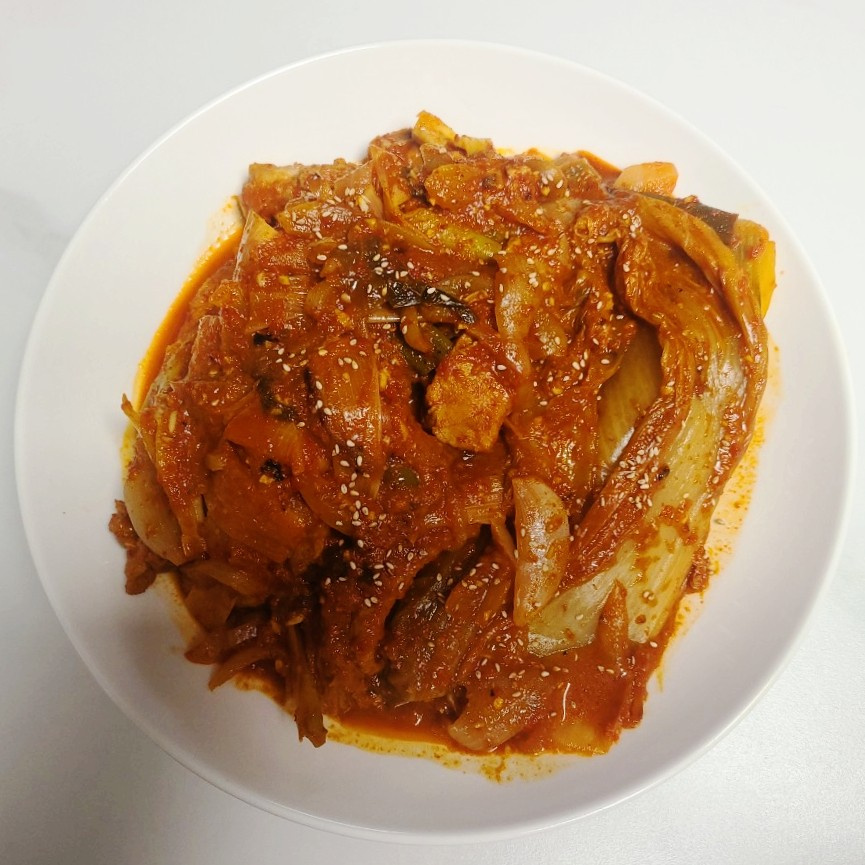Tender Pork Back Rib Kimchi Stew
The Ultimate Pork Back Rib Kimchi Stew Recipe, Perfect for Special Occasions

Here’s a recipe for pork back rib kimchi stew, quickly made to impress when guests visit. Traditionally, I soak the ribs in cold water to remove blood, but this time, I opted for a quicker method: rinsing thoroughly under cold water and then briefly blanching. This yields a cleaner, richer flavor.^^ (Please adjust seasoning to your taste. I tend to cook on the milder side, so feel free to add more soy sauce or other seasonings as needed.)
Key Ingredients for Pork Back Rib Kimchi Stew- Pork back ribs 1008g
- Well-fermented kimchi 520g
- Fresh green onions 100g
- Sweet onion 190g
- Spicy Cheongyang peppers 2
- Clear water 1L
Flavorful Seasoning Sauce- Savory soy sauce 4.5 Tbsp
- Spicy chili powder 3 Tbsp
- Cooking wine (for flavor and odor removal) 2 Tbsp
- Brown sugar (for a hint of sweetness) 1 Tbsp
- Spicy and savory red pepper paste 1.5 Tbsp
- Minced garlic 1.5 Tbsp
Blanching Ribs for a Clean Taste- Water for blanching ribs 1.5L
- Bay leaves 3
- Soju (for odor removal) 3 Tbsp
- Savory soy sauce 4.5 Tbsp
- Spicy chili powder 3 Tbsp
- Cooking wine (for flavor and odor removal) 2 Tbsp
- Brown sugar (for a hint of sweetness) 1 Tbsp
- Spicy and savory red pepper paste 1.5 Tbsp
- Minced garlic 1.5 Tbsp
Blanching Ribs for a Clean Taste- Water for blanching ribs 1.5L
- Bay leaves 3
- Soju (for odor removal) 3 Tbsp
Cooking Instructions
Step 1
Using kitchen scissors, cut the pork back ribs into individual portions. This helps the seasoning penetrate better and makes cooking more convenient.

Step 2
Place the cut back ribs in a bowl and fill it generously with cold water. Wearing gloves, gently massage the ribs to help release any remaining blood. Rinse the ribs by changing the water about 4 times until the water runs clear. This ensures a cleaner taste.

Step 3
Drain the rinsed ribs on a colander and let them sit for a moment to remove excess water. This prepares them for a cleaner blanching process.

Step 4
In a pot, combine 1.5 liters of water, 3 bay leaves, and 3 tablespoons of soju for blanching. Bring this mixture to a rolling boil over high heat.

Step 5
Once the water is boiling vigorously, add the prepared back ribs to the pot. Gently stir to ensure all the ribs are submerged in the water.

Step 6
When the water with the ribs starts boiling again, reduce the heat to medium and blanch the ribs for about 4 minutes. Be careful not to over-blanch, as this can cause the ribs to lose their juices.

Step 7
After blanching, individually rinse each rib under running cold water, gently rubbing with your hands to remove any foam or impurities from the surface. Place the cleaned ribs back on the colander to drain.

Step 8
Slice the onion into moderately thick strips. Cut the green onions to a similar length as the onion slices. Slice the Cheongyang peppers diagonally, also moderately thick, to add a pleasant spicy kick. Have your minced garlic ready (1.5 Tbsp).

Step 9
In a small bowl, combine 4.5 tablespoons of soy sauce, 2 tablespoons of cooking wine, 3 tablespoons of chili powder, 1 tablespoon of brown sugar, and 1.5 tablespoons of red pepper paste. Mix well until all ingredients are thoroughly combined, creating a delicious seasoning sauce.

Step 10
Now, in the pot you’ll use for the stew, place the blanched back ribs and the whole kimchi (after removing the tough core part). The kimchi will naturally break down as it cooks, allowing the flavors to meld beautifully.

Step 11
Add 1 liter of water, the sliced onion, green onions, and minced garlic over the ribs and kimchi.

Step 12
Pour the prepared seasoning sauce evenly over the ingredients in the pot.

Step 13
To help distribute the sauce evenly, ladle some of the liquid from the pot over the sauce and stir gently to combine everything. Then, bring the stew to a boil over high heat.

Step 14
Once the stew is bubbling vigorously, reduce the heat to medium-low. Gently stir the ingredients to prevent sticking, then cover the pot with a lid to allow it to simmer and tenderize.

Step 15
Simmer covered on medium-low heat for about 30 to 40 minutes. During this time, lift the lid occasionally and stir the contents to prevent the ribs and kimchi from sticking to the bottom or burning.

Step 16
After about 30 minutes of simmering, remove the lid completely. Check the consistency of the broth and the seasoning. If it tastes too bland, add a little more soy sauce to adjust. If the broth has reduced too much, add a splash of water and let it simmer for a short while longer to reach your desired consistency.

Step 17
Finally, about 15 minutes before serving, reduce the heat to low and remove the lid to allow the broth to reduce further. When the broth is slightly thickened, the kimchi is tender and easily shreddable, and the meat is falling off the bone of the back ribs, your delicious Pork Back Rib Kimchi Stew is complete!^^



